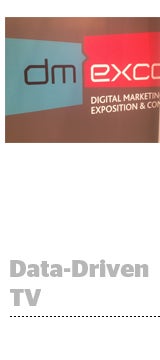 Marketers are under enormous pressure to target users from tablets to connected TVs, but the supply side needs to feel incented in order for programmatic TV to take hold.
Marketers are under enormous pressure to target users from tablets to connected TVs, but the supply side needs to feel incented in order for programmatic TV to take hold.
This was a theme emerging from the DMEXCO show Thursday where a mashup of marketers, agencies and tech companies mixed for two days in Cologne, Germany.
“What we’re seeing from the numbers is people are watching more TV,” said Jim Clayton, EVP of the new business division at LG, during a discussion on addressable TV with Jean-Pierre Fumagalli, CEO of Smartclip; Michael Shehan, CEO of SpotXchange; and Iain Jacob, president of dynamic markets at Starcom MediaVest.
With reports of rampant cord-cutting among the Millennial crowd, it’s easy to make the assumption that TV is losing clout, but Clayton argued there has been a “reaggregation” of viewers on new OTT devices, whether they be Roku or Apple TV.
“We as marketers and advertisers have to follow the consumer,” Fumagalli said. “The tablet is the television screen. … Samsung and LG are leading the way, but there’s also Apple, the platforms like Google who want to get into this and then big broadcasters with big brands and audiences.”
Although traditional TV advertising still commands $70 billion in advertising spend to addressable TV’s comparatively tiny $200 million, the latter’s share of spend could increase as marketers bring their first- and third-party data to the TV medium. They’re largely not doing that in real time yet.
“You can think about what happens to television advertising over a very long term where the argument is that the future of television advertising goes programmatic,” Rhys Noelke, VP of business development at RTL Group, the European entertainment and broadcast company that acquired SpotXchange in July, told AdExchanger. “Premium so far is a direct relationship, but we also want to be prepared. For the moment we’re obviously not interested to sell premium channels by computer programs, but the development eventually could go in that direction.”
In a separate session at DMEXCO, one marketer posed a question to Matt Seiler, global CEO of IPG Mediabrands, that “what if buying TV could be as easy as buying on Facebook?”
“The greatest concern publishers had initially was the value of their media would decrease, but that hasn’t happened,” Seiler said. “It’s like Uber – the price increases when it’s raining or there’s traffic. That’s a scary thing for TV guys to get a handle of. … Why would TV sellers lose the upfront when it’s efficient for them? Some guys in TV don’t want things to change. The margins are good.”
As SpotXchange’s Shehan pointed out, while marketers want to cherry pick specific households and get more granular in targets, “I see particular challenges with the broadcasters and MVPDs if certain advertisers buy certain segments of audience. Do some segments not get sold?” A huge broadcaster imperative is deciding what constitutes premium content and to what degree excess inventory is packaged programmatically.
But there is innovation in this regard from the sell side and, in many cases, collaborative efforts around data application. Some satellite, broadband and telephone providers such as British Sky Broadcasting have developed services such as Sky’s AdSmart, which let advertisers incorporate first-party data into “preferred audience segments,” coupled with Sky’s base of viewer and subscriber attributes.













